
The Split East Turn proposal by Seattle-Tacoma Airport in 2001 would have directed full-throttle airliner take-offs directly over Renton neighborhoods.
Twenty-four years ago I received an urgent phone call from Mayor Jesse Tanner: “Randy, I need you to meet with Mercer Island tonight. They’ve learned of a distressing proposal by SeaTac Airport. I’m going to stay in my office tonight and make phone calls to learn more.”
A proposed change would route SeaTac airliners in full-throttle takeoff directly over Renton neighborhoods. This would happen when winds were coming from the the north, typically during our warm sunny days when we have windows open and people are enjoying the outside.
“Wouldn’t this conflict with Renton Airport Traffic?” I asked Mayor Tanner, who had been a high-level FAA executive before serving as our Mayor. “No, they could do it. He said. They’ll be just above Renton traffic, crosswise to it. Renton traffic might get a lower ceiling”
Renton residents and officials raised strong objections to this change. Mercer Island led a coalition that helped turn back the proposal. Our meetings on Mercer Island were technical, organized, and urgent.
The proposal had taken flight partly because Eastside cities including Medina, Hunts Point, Clyde Hill, and north Bellevue had been put in the SeaTac takeoff path a decade earlier, when SeaTac Airport adopted the “4-Post” Traffic Pattern. Eastside cities were unhappy about this, because in previous decades the SeaTac traffic pattern was all west of the airport.
So in 2001, with the third-runway in work, these cities felt that Renton and Mercer should absorb some of the take-off traffic. But the airliners would have been only about half as high above our homes as theirs, which would make them much louder.
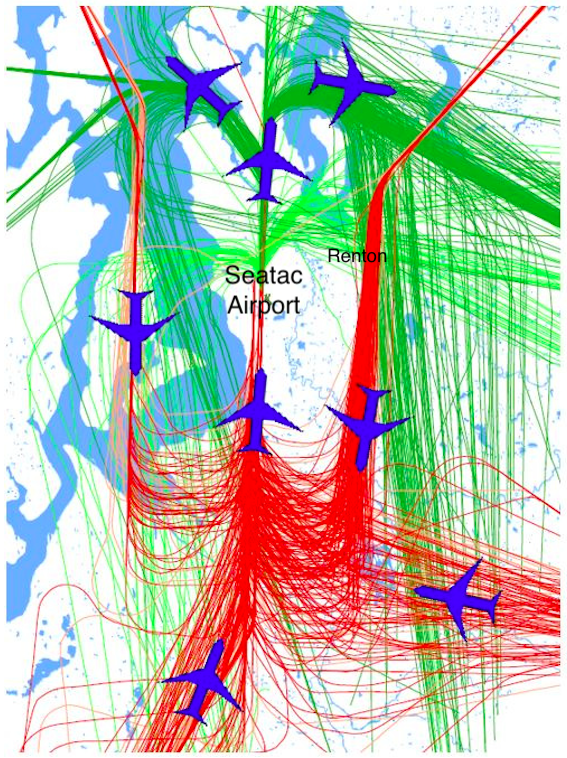
The northerly SeaTac take-off pattern today, unchanged since 1990. Jet departures (in green) are typically a mile above Renton and spread out to Issaquah. Jet arrivals (in red) are also high over Renton, and at quieter throttle settings. (Port of Seattle website image reflecting northern departure, typical in warm, sunny weather)
The proposal was called the “Split East Turn”. In the end, after months of technical work and lobbying, Renton, Mercer Island, and Newcastle celebrated as the “Split East turn” was dropped from consideration. The airport’s data showed that if they implemented the Split East Turn a greater number of people would be awakened by jets at night even with their windows closed ( including hundreds of Renton residents). And about the same number would be “Highly Annoyed” whether they implemented the change or not– i.e. it would not reduce annoyance.
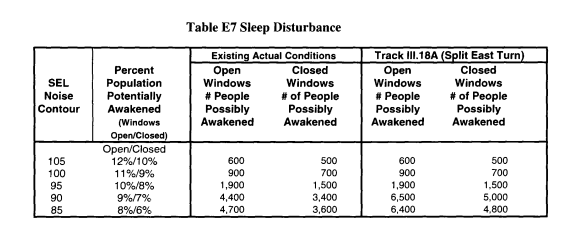
This chart from this report shows the Split East Turn would have awakened more residents than the existing condition
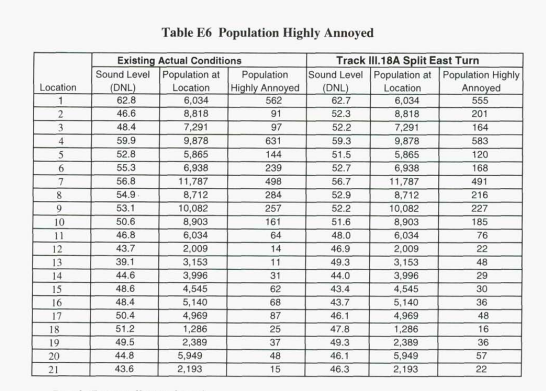
Renton and Mercer Island’s anticipated “highly annoyed” population helped quash consideration of the Split East Turn. This table is from this report.
For my next 20 years on Council, I maintained awareness of SeaTac issues, making sure the proposal did not come back.
With population growth, SeaTac Airport’s 4-post flight pattern is unfortunately becoming saturated, similarly to how Boeing Field is running out of capacity. There are people on the Eastside that would still like Renton to have SeaTac takeoffs over Renton homes. But the state should not expect the residents of Renton to shoulder the pain of fixing statewide airport capacity problems that were caused by insufficient statewide planning. Renton airport officials and elected officials should be aggressively advocating for new airports elsewhere. Our leaders should promote our approved Renton Airport Sustainability Plan and lean on our RAAC for technical advice, not offer to fix the capacity limitations of other airports by bringing in private jet centers. Public statements by some officials that welcome more jet traffic are contrary to our residents’ interests.
Our officials should support our residents who insist on quiet during sleeping hours and complain when they hear excessive jet noise (residents who have saved us in the past.) Otherwise, we could end up with 747s at full throttle taking off above our homes.
The report that covers the Split East Turn is available here.
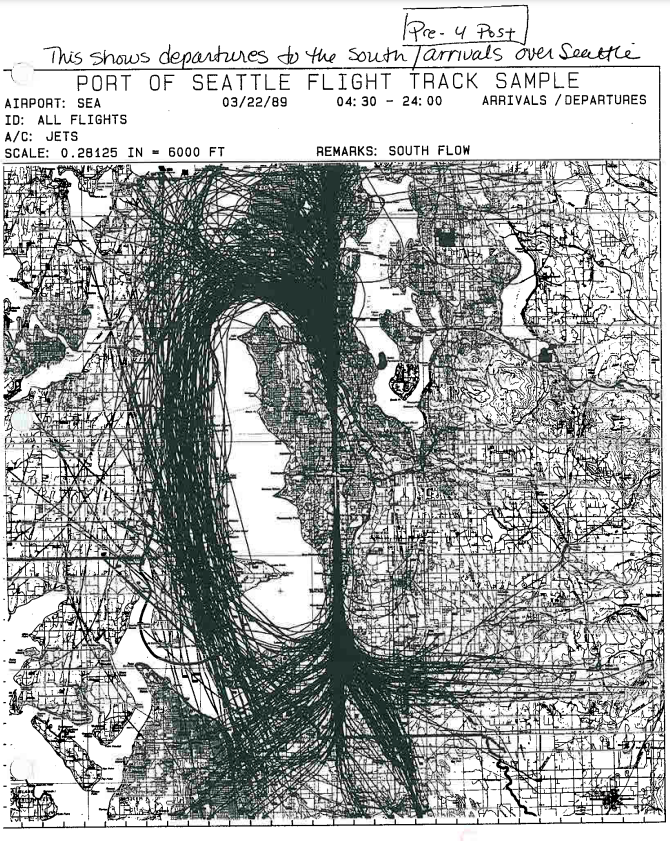
Before the 1990 4-post pattern, SeaTac airport traffic was west of the airport (from seatacnoise.info)
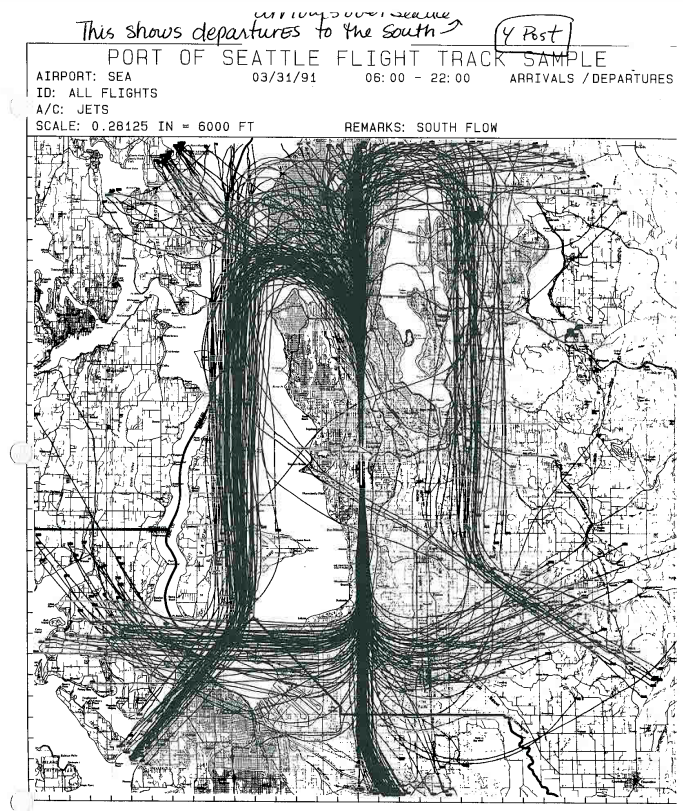
The SeaTac 1990 4-post traffic pattern put half of the traffic over the Eastside. (from seatacnoise.info)


When I was on the Renton Airport Community Coalition (RACC), we almost had another significant change in air traffic under the FAA’s “Greener Skies” program in the early mid 2010’s. The program would have used GPS to direct planes away from high-traffic corridors.
One reason Renton didn’t experience major overflights at that time was because the Renton Municipal Airport was mainly used by Boeing 737 aircraft, which need to reach a certain altitude for safety. This aspect kept other flights from flying over Renton. RACC reminded the FAA of this.
RACC’s work was beneficial, and I think it should continue. We managed to avoid many potential issues, and I believe the efforts by RACC contributed to why Renton doesn’t currently have an extended runway into Renton high school filled with business jets.
Greener Skis Info:
https://www.faa.gov/sites/faa.gov/files/air_traffic/environmental_issues/ared_documentation/ea_SEA_GreenerSkies_Vol1_FONSI_ROD_121030.pdf
Thank you Ben for sharing the info about “Greener Skies,” and also for the important role that you and the RAAC played in keeping it from impacting Renton. People living west of SeaTac were negatively impacted by this program, because even though it sounds like it has an environmental advantage, it puts even more airplanes on exactly the same flight path. For people living under the “greener sky” it’s not greener– it’s more polluted and noisier, and they never get a break in the noise.
When are you going to cover that Boeing building almost burning down like you predicted? And why is the city letting them get away with it?